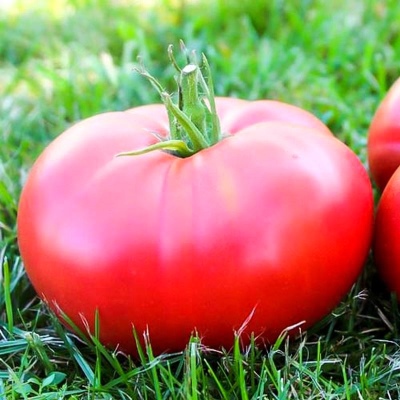
- Authors: Z. I. Schott, M. A. Gilev (LLC Aagrofirma "Demetra-Siberia")
- Year of approval: 2007
- Category: grade
- Growth type: indeterminate
- Appointment: fresh consumption, for juice
- Ripening period: mid-season
- Ripening time, days: 110-115
- Growing conditions: for open ground, for film greenhouses
- Bush size: tall
- Bush height, cm: 150-180
Altai pink tomato is a plant that brilliantly confirms the advantages of Siberian selection. A large number of gardeners need to get acquainted with it better. And, as usual, you should start with the origin of this crop and the general varietal characteristics.
Breeding history
The Altai pink tomato was developed in the experimental farm of Agrofirma Demetra-Siberia LLC. The main management of the breeding project was taken over by Schott and Gilev. The plant was presented to the public and approved for open use in 2007. The culture is fully adapted to domestic conditions.
Description of the variety
Altai pink is a typical indeterminate variety. Its bushes reach great heights (in different cases from 1.5 to 1.8 m). They are characterized by powerful development of stems. The green foliage is small. Amplitude is not typical.
The main qualities of the fruit
Altai pink tomatoes are green when unripe. Forms a dark green spot near the peduncle. Ripe berries acquire a raspberry-pink color. Weight of 1 fruit varies quite strongly, from 300 to 500 g. Flat-round shape and poor development of ribbing are typical for them.
Other important parameters:
dense rind;
development on a simple inflorescence;
articulated peduncle.
Taste characteristics
The fruits of Altai pink are sweetish. Their flesh is pink (which gave the culture its name). And also note the meatiness and juiciness of each instance.
Ripening and fruiting
The tomato of this variety belongs to the mid-season group. After pecking green shoots, you will have to wait for the harvest from 110 to 115 days. Only a serious deterioration in weather conditions can change this date. The fruits will form for quite a long time. Usually, the collection takes place from mid-summer until the onset of the early cold weather.
Yield
Altai pink gives a solid amount of berries. In terms of 1 sq. m this figure is 10 kg. With competent agriculture, 1 plant can supply 4 kg of fruit. In case of frost, it is possible to save the situation only with good shelter.
The timing of planting seedlings and planting in the ground
Sowing seeds in planting boxes should be at the very end of February or in the first days of March. Typically, the seedlings will be ready to move to permanent cultivation sites in the last decade of April. Sometimes this readiness is achieved on the May holidays or even a little later. Seedlings can be dived at the phase of 2 true leaves. When planting seedlings in a permanent place, you need to place 3 plants per 1 "square", but if they are formed according to the 1-stem method, then you can add another copy.

Growing tomato seedlings is an extremely important process, because it largely depends on whether the gardener will be able to harvest at all. All aspects must be taken into account, from seedbed preparation to planting in the ground.
Landing scheme
The one-line option is most often chosen. According to it, the gap between individual plants will be 0.5 m. The row spacing will be 0.7 m. There are no more subtleties with the planting scheme.

Growing and care
Seedlings must be prepared very carefully and scrupulously. Before planting, the seeds are disinfected with a solution of potassium permanganate and empty specimens are discarded. Treatment with compounds that increase germination and development rate is welcomed. Seedling soil must be taken from a regular garden. It is very good if it is mixed with a small amount of ash or sand.
The best open ground planting site is where cruciferous crops used to grow. But peppers and eggplants are not the most worthy predecessors. The earth should be loosened thoroughly, but it is even better if it was initially loosened. Before planting, the planting holes are saturated with fertilizers. Rods are used as supports, in isolated cases - trellises.
Watering Altai pink can only be done with warm water after preliminary settling. Drying of the topsoil acts as a guideline for watering. Top dressing for the growing season is carried out 3 or 4 times. Their number is determined by the condition of the plant, but too much nutrients should not be added. In case of excessive stretching of the bush, it is better to cut off its tip.




A plant needs different micronutrients at each stage of growth. All fertilizers can be divided into two groups: mineral and organic. Folk remedies are often used: iodine, yeast, bird droppings, eggshells.
It is important to observe the rate and period of feeding. This also applies to folk remedies and organic fertilizers.
Disease and pest resistance
Altai pink resists well both insects and main tomato infections. However, farmers will still only benefit from quality injury prevention. Along with branded drugs, potassium permanganate and copper sulfate help to forestall it. The systematic loosening of the earth helps to protect plantings from root rot. Highly toxic drugs can be used only before the formation of berries, later they use household improvised means.


Growing regions
The variety is almost universal. It is permissible to grow it:
in the Far East;
throughout the Volga region;
in the Central Black Earth Region;
in the regions and republics of the North Caucasus;
in various areas of the Urals and Siberia.

























































































